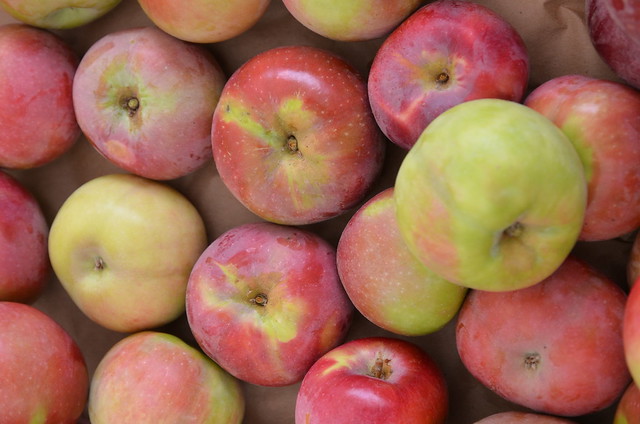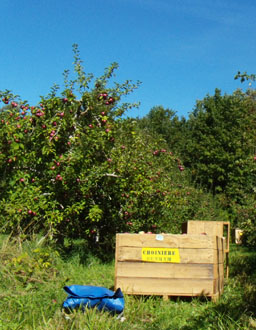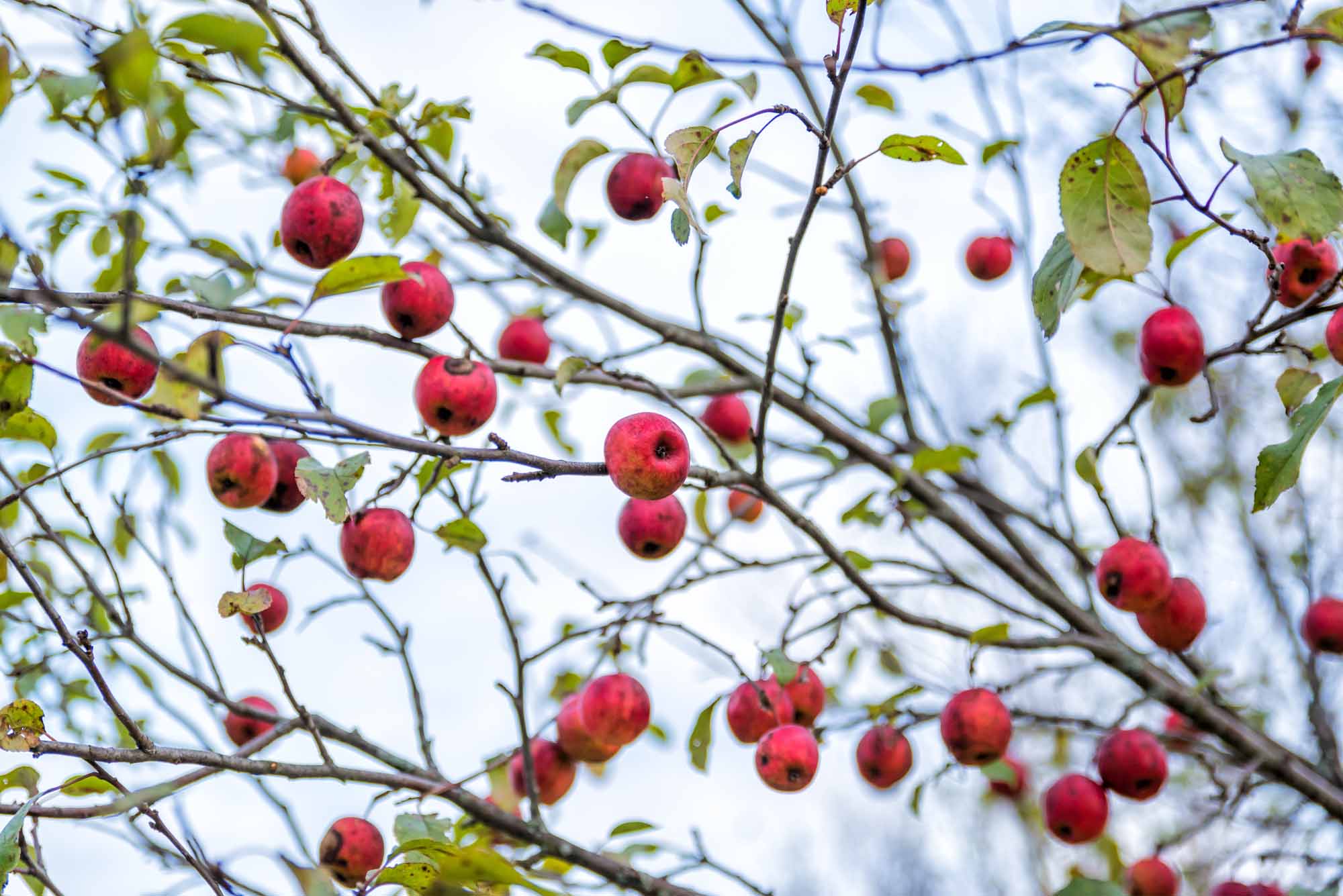The McIntosh apple (Malus domestica “McIntosh”) is often called the national apple of Canada. Discovered in 1811 by John McIntosh on his Ontario farm, the McIntosh apple has been commercially available since the 1880s. It is grown mostly in eastern Ontario, British Columbia’s Okanagan Valley, and the northeastern United States. The skin of this medium-sized apple is mostly bright red, but often includes green and white areas. The flesh is white, crisp and tart tasting. The McIntosh is one of the top 10 apples sold in North America.

Description
McIntosh apples are considered medium-sized. Other apples, such as idared, are larger, while apples such as golden russet are smaller. The skin of the McIntosh apple is bright red with green areas, and often dotted with white spots. The flesh is white and crisp and has a tart taste. The apple is called an “all-purpose” apple because it can be used cooked or raw. From the beginning of its cultivation, it was highly praised as a dessert apple.
The tree grows between 2 to 5 meters tall. Its single trunk supports many branches, some of which need to be cut off (thinned) to produce proper-sized apples. Thinning allows more sunlight to reach the growing fruit. In early spring, McIntosh trees are covered with pink buds, which open into clusters of five-petaled white flowers, with pink accents.
Did you know?
MacIntosh computers are named for the McIntosh apple. In 1979, Jef Raskin, an Apple Computer, Inc. employee, began work on the MacIntosh computer. He named the project “McIntosh” after his favourite apple. However, there was already a trademark on the name, so the company modified it slightly.
Habitat and Range
McIntosh apple trees grow best in areas that have warm, sunny days and cool nights. It’s very winter hardy, meaning it can survive winter temperatures as low as -34°C. The McIntosh apple is one of the most northern growing apples in Canada.
Orchards of McIntosh apples thrive in eastern Canada (especially along the shores of Lake Ontario, Lake Erie, Lake Huron, and Georgian Bay), in British Columbia (mainly in the Okanagan Valley), and in the northeastern United States.
Cultivation and Pollination
The McIntosh apple is a cultivar, which is a plant chosen and grown for its desired characteristics. The tree bears annually — flowering in early to mid-May, and ripening in mid-to-late September. It is not self-pollinating. The McIntosh belongs to a large group of apples that need cross pollination from a nearby apple tree to bear fruit. That tree should be a different variety of Malus domestica. Bees are the main carriers of pollen from one apple tree to another.
All apple trees are known as “extreme heterozygotes,” which means that each tree planted from seed will produce unique and unpredictable fruit — often only distantly related to their parent DNA. For this reason, specific varieties of apples, including the McIntosh, are reproduced by grafting. This means branches are cut off a bearing tree and spliced onto a new tree, usually a winter-hardy apple variety. Grafting ensures the resulting apples have the same characteristics (taste, colour, hardiness, etc.) as the original variety.
History
Apples are one of the oldest foods known to humankind. Some experts believe the earliest apple trees appeared in Central Asia thousands of years ago. Apples are not native to Canada. Apple trees were not grown in Canada until the early 1600s, when the first French settlers began planting orchards.
The original McIntosh apple tree was discovered by John McIntosh on his farm in Dundela, Ontario, in 1811.
No one knows the exact parentage of the McIntosh. John McIntosh discovered the original McIntosh in 1811. The young tree was found in an overgrown part of his orchard on his Dundela farm in Upper Canada (now Ontario).
The family greatly prized these apples. John’s son Allan is credited with grafting the cultivar onto winter-hardy roots of another apple tree. By 1835, Allan was growing McIntosh trees and selling them in his immediate area and into the northeastern United States. In 1870, it entered commercial production under the name “McIntosh Red.” As a result of the Dominion Horticulturist W.T. Macoun’s praise, by 1900 it was one of the most popular apples in northeastern North America.
Did you know?
The original McIntosh apple tree died in 1906 after being damaged by fire. There’s a historic marker next to the spot where the tree stood in Dundela, Ontario. The last known tree grafted from the original McIntosh died in 2011, also at an orchard in Dundela. A clone from this tree is now growing at Upper Canada Village, a living history museum near Morrisburg, Ontario.
Production
The McIntosh apple is one of the most widely grown apple varieties in Canada. For example, in 2017, 21 per cent of apples produced in Ontario were McIntosh apples, followed by gala (15 per cent) and empire (13 per cent). Similarly, McIntosh apple trees are one of the top five apple cultivars used for cloning in the country, and some popular commercial cultivars, including Spartan, cortland, and empire apples, have the McIntosh as one of their parents.
The McIntosh is harvested in one or two pickings. It lasts up to eight weeks (said to be a short time compared to other apples) in cold storage in temperatures of 1°C. It stays crisp and flavourful longer in controlled atmosphere storage facilities, where the temperature, humidity, nitrogen and carbon dioxide levels are controlled. Developed in the 1930s, this technology slows the apples’ respiration so that they don’t ripen as fast. Controlled storage allows the McIntosh apple to be sold to the public over a longer period of time.
Apple Scab
The McIntosh is very susceptible to apple scab because of its genetic make-up. This disease is caused by the spores of the fungus Venturia inaequalis. The spores are carried on the wind from infected damp, dead leaves lying on the ground near the trees. When the spores land on the tree, they grow and mature and then can release more spores to infect ripening fruit. The growing spores cause black spots to form that expand into large, hard brown areas on the fruit. Because the flesh of the apple is not affected, peeled apples can still be eaten. However, infected fruit is not saleable. The infection can be somewhat controlled by clearing away dead leaves in the fall, but many growers spray their trees with fungicides as an extra precaution.
When did the Apple tree arrive in Canada and why do some trees in B.C live over a thousand years? A quick peek into some of the history kept by our land’s oldest living knowledge keepers — trees.
Note: The Secret Life of Canada is hosted and written by Falen Johnson and Leah Simone Bowen and is a CBC original podcast independent of The Canadian Encyclopedia.

 Share on Facebook
Share on Facebook Share on X
Share on X Share by Email
Share by Email Share on Google Classroom
Share on Google Classroom



